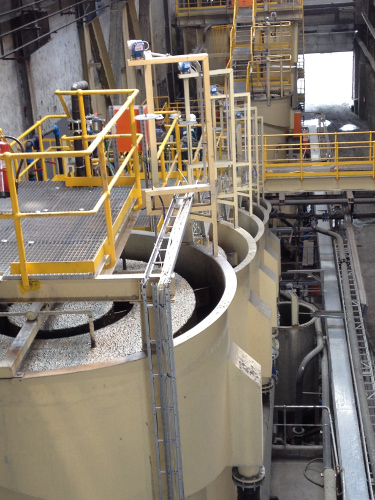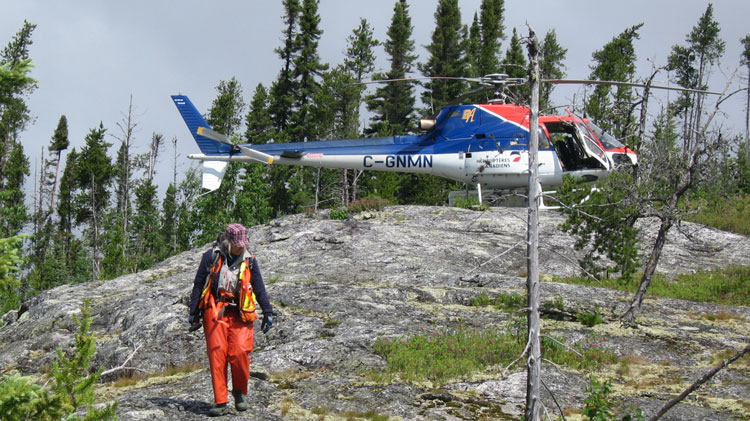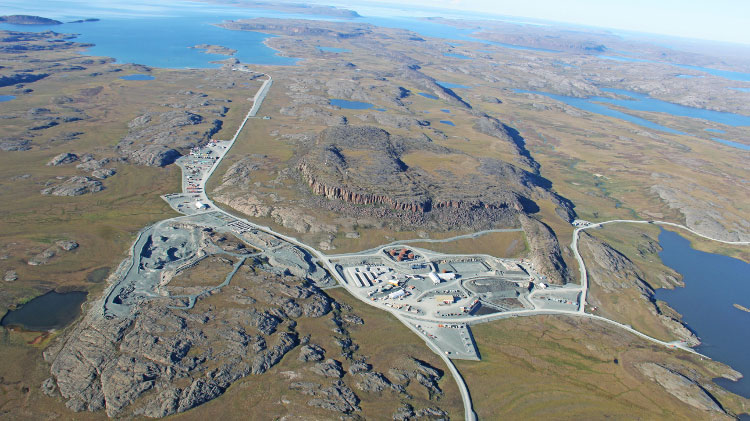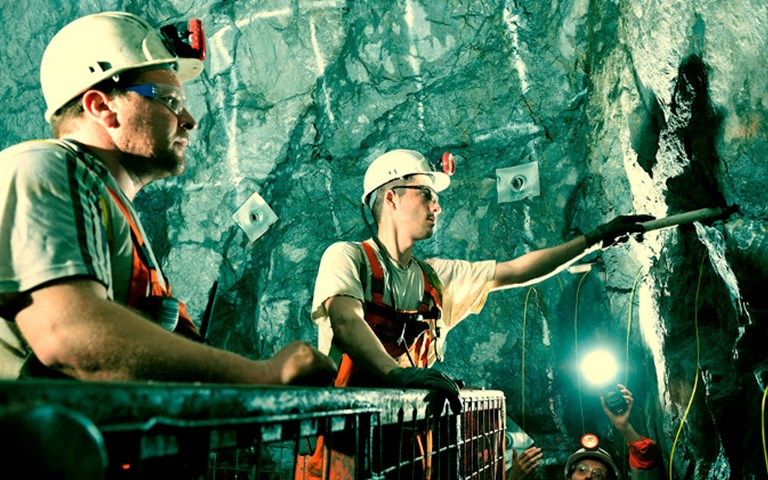Part of the mine transformation under Dundee ownership included the transition from sublevel caving to the more selective mining method of blast hole stoping. Courtesy of Dundee Precious Metals
Dundee Precious Metals bought the Chelopech gold-copper mine in Bulgaria in 2003 to make a low-cost move into mining operations. When Rick Howes joined the company in 2009 as the mine’s general manager, he says he viewed it as an opportunity to invest in the kinds of innovation he had long envisioned at a mine site. Today, both ambitions have been realized. Annual throughput from Chelopech has nearly quadrupled, unit costs have sunk, and a real-time production management system has provided a pathbreaking model for underground mines.
Chelopech is in the Panagyurishte mining district of central-western Bulgaria, containing a number of massive sulphide and porphyry copper deposits. Under state operation from 1954 to 1992, it struggled to remain viable in the 1990s as Bulgaria underwent democratization and privatization. DPM acquired Chelopech after its previous owner went bankrupt. The mine has good bones; its current Proven and Probable Reserves measure 2.512 million ounces of gold at 3.26 grams per tonne, 5.674 million ounces of silver at 7.37 ounces per tonne, and 524 million pounds of 0.99 per cent copper. But its new owners saw a need and an opportunity to modernize the operation.
“Most of my experience is in the large mining operations in Canada,” explains Howes, who is now the president and CEO of Dundee Precious Metals (DPM). “I spent almost 30 years with Inco (now Vale) and Falconbridge (now Glencore). We tried many of these ideas, but they weren’t successful for various reasons. One was the technology at the time wasn’t nearly as advanced and cost-effective as it is today. And two was a stubborn unwillingness to take a risk on innovation.” With the right combination of technology and concept, Howes says he believed he could run an efficient mine using a new suite of tools.
In the early years, DPM focused on updating its mining method and infrastructure. Chelopech’s previous owners had used sublevel caving on the relatively small ore bodies, which diluted the ore and caused cave areas to form on surface. DPM switched to more selective and productive blast hole stoping with filling of the mine voids after mining. Along with building an access ramp and backfilling with paste fill, the changes doubled production from half a million to a million tonnes of ore per year. Next, DPM installed a conveyor system and put a crusher at the bottom of the mine for bringing the ore to surface instead of trucking and shaft hoisting, cutting mining costs by around 20 per cent and doubling production to two million tonnes of ore per year.
At the same time, staff at DPM understood that they would require a new way to manage their resources if they wanted to double throughput without adding new equipment. So in 2009, Chelopech commenced a plan called “Taking the Lid Off.”
Taking the lid off
Howes borrowed a manufacturing concept called “Short Interval Control,” which uses real-time production information to update a central monitoring and control room. At Chelopech, a master schedule plans activities at least three months in advance, with a detailed breakdown into weekly production, support and services tasks. Management sets production and performance targets that are checked against actual outcomes at short-term intervals throughout the working shift.
A control room supervisor uses Dassault Systemes Geovia InSite shift management software to view a shift-by-shift schedule for the next seven days. At the end of one shift, the control room supervisor and the shift supervisor make any necessary adjustments for the next shift and then assign tasks. The weekly goal is to complete as much of the scheduled work as possible. If all planned tasks are completed then planned production output is all sustainably achieved.
Equipment operators receive the tasks via a wireless network on tablet computers using software provided by Sandvik, the main mine production equipment supplier at Chelopech. The information for each task includes the location, output and expected time required. The operator updates the control room via the tablet throughout the shift.
Sandvik machines have health and production sensors that alert both operator and maintenance if warning signs develop. If a task is drifting behind schedule, the control room supervisor can inquire and take immediate course-correcting action.
Personnel and equipment are tracked using AeroScout radio-frequency identification (RFID) tags inside their cap lamps or vehicle cab. A software location engine finds their physical location using the signal strength relative to the closest wireless access points. The location is displayed in two different software applications: a specialized AeroScout application called MobileView and the level plan view of InSite.
A wireless communications network covering nearly the entire mine forms the backbone of the system. That makes Chelopech unusual. Although many underground mines use radio communications, only a few are using wireless computer networks. The advantage is that wireless networks used for the Internet and computer networks in the office or at home are a common component of everyday life and relatively inexpensive. They support voice, video and data with off-the-shelf software and hardware. “All we did was ruggedize the components for underground use and modify some of the technology to better suit the mining needs,” explains Howes.
“The cost to put in the new technology was pretty much less than what it would cost us to expand our existing leaky feeder system,” he says. DPM bought off-the-shelf Cisco components and made in-house customizations, including longrange wireless antennas and ruggedized voice-over-Internet phones. It took about 150 to 200 wireless access points to get full coverage.
Change management
The system may sound seamless but it required three years of hard work by DPM and seven different partners, including hardware, software, systems integration, and project management providers. Most critically, DPM partnered with its software vendors and Sandvik’s Trans4Mine consulting arm to design both the new workflow and the processes that would help employees understand it.
Where employee buy-in to the innovations was concerned, the project leaders did not have to work too hard to sell the ideas. He says Bulgarian workers are open to change. “When we told them that this is about more efficient use of resources – helping you to be successful at achieving your task, eliminating some of the barriers to your success so that you can do well – this approach was easy to implement,” says Howes.
The vendors needed to trust one another and to define their roles cooperatively; that proved tough work at first. “Trying to get various parties to share their proprietary information was probably the biggest challenge,” says Howes. “But once there was a willingness to do that, then we were able to integrate the pieces.”
In financial terms, suppliers to Chelopech contributed substantially to the project. DPM spent a fairly modest $3 million on its new production management system, counting both in-house expenses and vendor fees, but individual suppliers invested their own funds into research and development as well.
For example, Sandvik needed to develop its tablet system from scratch, according to Mike Andrews, business line manager for Sandvik’s automation and Trans4Mine business units. “Rick and his team provided a lot of the user requirements for us,” he says, “but most of the software still needed to be developed, as well as the hardware to go with it.”
Sandvik welcomed the opportunity to take on the project. Having begun to develop advanced monitoring solutions, it needed specific directions from a mining company. Partnering with Chelopech allowed Sandvik to design its solution around the needs of the mine. Not every customer wishes to give that kind of direction. Yet, says Andrews, “From the ones that do have the visionary approach like the Chelopechs, we can learn so much. And it stands us in good stead going forward with other customers. We know we’ve designed something that is functionally correct and required by the markets.” Sandvik has since submitted three to four tenders for similar systems at other mines in Africa, Europe, Australia, and the Americas.
Better flotation
Trying out new ideas did not stop when the implementation phase of Taking the Lid Off ended in 2012. Over the last two years, Chelopech has replaced its aging flotation tanks with staged flotation reactors (SFRs), a new design that halves overall power consumption, uses half the floor space, and produces better selectivity and higher recoveries for less than the cost of putting in a conventional tank. Chelopech was the second mine to install an SFR; the first was Anaconda’s Pine Cove gold mine in 2010.
 |
|
The mine operators opted for staged flotation reactors to replace the aging flotation tanks. The technology breaks up the flotation process into three distinct stages: particle collection, de-aeration of slurry tailings and froth recovery. They recently added another SFR circuit for pyrite recovery. Courtesy of Woodgrove Technologies
|
Manufacturer Woodgrove Technologies, Inc. premised its design on three separate processes involved in flotation: particle collection, de-aeration of the tailings slurry and froth recovery. Christopher Bennett, business development director at Woodgrove, explains that each of these processes requires a different environment. Collection demands strong shear forces and high turbulence levels; de-aeration requires a quiescent environment; and froth recovery requires a quiescent environment near the top of the cell so there are no shear forces to break the froth bubbles.
“It seems counterproductive to attempt to execute all three processes in the same tank,” says Bennett. “So we have designed the cell to have three separate chambers and two tanks.” One turbulent tank promotes collection; the other tank, divided into two chambers, is quiescent so that deaeration and froth recovery can take place unimpeded. Each chamber, or reactor, has a geometry and volume tailored to its specific duty. Most importantly, the surface area within the froth recovery chamber matches the amount of froth generated.
Bennett says that using three sized-for-duty chambers has a few different benefits. It optimizes energy utilization, since energy is used only for collection and not for sand suspension. It also improves recoveries, largely because froth recovery is more effective. Finally, the method by which air is added – cycling through the impeller zone several times – reduces the total air use to about one-sixth of a typical tank cell and improves selectivity in the presence of floatable gangue minerals, like the pyrite at Chelopech. Any air beyond the quantity needed to float valuable species will only entrain water to the froth, bringing hydrophilic gangue with it.
Fine-tuning the product
The mine’s primary product is a copper concentrate shipped to DPM’s smelter in Tsumeb, Namibia. In the first half of 2014, Chelopech produced 56,106 ounces of gold, 20 million pounds of copper and 101,700 ounces of silver in concentrate.
DPM also contemplated building a pyrite recovery circuit and a pressure oxidation facility so that it could produce a pyrite concentrate and then extract gold from it on site. The $14-million pyrite recovery circuit went up as planned with the flotation circuit consisting entirely of staged flotation reactors; it began producing concentrate within the existing surface mill facility in early 2014. But current market conditions do not justify the pressure oxidation facility, so for now Chelopech is selling its pyrite concentrate to customers in Europe and China.
DPM recently extended the life-of-mine at Chelopech to 2025; that offers plenty of time to introduce a new technology or two. But even if management stays conservative from here on out, they will have demonstrated – having boosted throughput from 550,000 tonnes of ore to two million tonnes and shrunk costs from $66 to $40 per tonne – that a small company with a good idea and a good team can break new ground.





